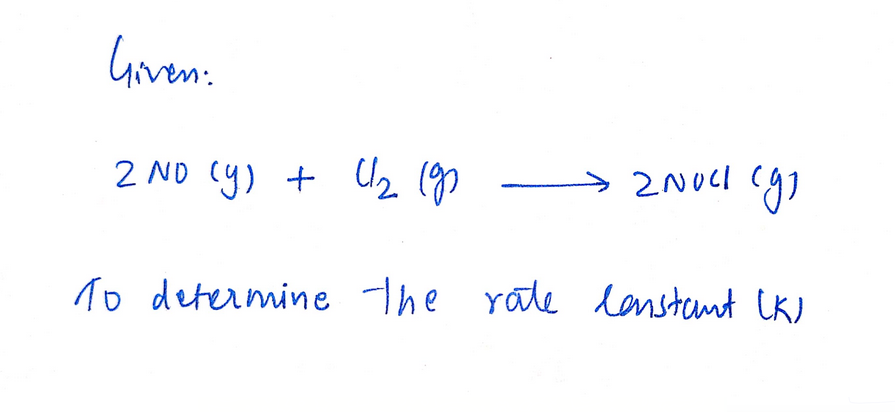Given the following data, determine the rate constant of the reaction 2NO(g) +Cl, (g) + 2NOCI(g). Experiment 1 2 3 O a) 59.6 M 2-1 Ob) 1.13 [NO] (M) 0.0300 0.0150 0.0150 M-25-1 c) 37.8 M-2-1 d) 9.44 M-25-1 0.0265 M 25-11 [Cl₂) (M) 0.0100 0.0100 0,0400 Rate (M/s). 3.40 10 4 8.50 10 5. 3.40 104
Given the following data, determine the rate constant of the reaction 2NO(g) +Cl, (g) + 2NOCI(g). Experiment 1 2 3 O a) 59.6 M 2-1 Ob) 1.13 [NO] (M) 0.0300 0.0150 0.0150 M-25-1 c) 37.8 M-2-1 d) 9.44 M-25-1 0.0265 M 25-11 [Cl₂) (M) 0.0100 0.0100 0,0400 Rate (M/s). 3.40 10 4 8.50 10 5. 3.40 104
Chemistry
10th Edition
ISBN:9781305957404
Author:Steven S. Zumdahl, Susan A. Zumdahl, Donald J. DeCoste
Publisher:Steven S. Zumdahl, Susan A. Zumdahl, Donald J. DeCoste
Chapter1: Chemical Foundations
Section: Chapter Questions
Problem 1RQ: Define and explain the differences between the following terms. a. law and theory b. theory and...
Related questions
Question
![**Determining the Rate Constant of a Reaction**
*Given Reaction:*
\[ 2NO(g) + Cl_2(g) \rightarrow 2NOCl(g) \]
*Experimental Data:*
| Experiment | \([NO]\) (M) | \([Cl_2]\) (M) | Rate (M/s) |
|------------|--------------|----------------|------------------|
| 1 | 0.0300 | 0.0100 | \(3.40 \times 10^{-4}\) |
| 2 | 0.0150 | 0.0100 | \(8.50 \times 10^{-5}\) |
| 3 | 0.0150 | 0.0400 | \(3.40 \times 10^{-4}\) |
*Options to Determine Rate Constant \(k\):*
a) \(59.6 \, \text{M}^{-2}\text{s}^{-1}\)
b) \(1.13 \, \text{M}^{-2}\text{s}^{-1}\)
c) \(37.8 \, \text{M}^{-2}\text{s}^{-1}\)
d) \(9.44 \, \text{M}^{-2}\text{s}^{-1}\)
e) \(0.0265 \, \text{M}^{-2}\text{s}^{-1}\)
**Instructions:**
Analyze the data to calculate the rate constant \(k\) for the given reaction using the method of initial rates. Determine which option represents the correct rate constant.](/v2/_next/image?url=https%3A%2F%2Fcontent.bartleby.com%2Fqna-images%2Fquestion%2Ffc7deb2c-0862-415e-88b2-023e0d274874%2F120b6f19-06ed-4f45-91bf-fe04d83ddc00%2F5dff3oa_processed.png&w=3840&q=75)
Transcribed Image Text:**Determining the Rate Constant of a Reaction**
*Given Reaction:*
\[ 2NO(g) + Cl_2(g) \rightarrow 2NOCl(g) \]
*Experimental Data:*
| Experiment | \([NO]\) (M) | \([Cl_2]\) (M) | Rate (M/s) |
|------------|--------------|----------------|------------------|
| 1 | 0.0300 | 0.0100 | \(3.40 \times 10^{-4}\) |
| 2 | 0.0150 | 0.0100 | \(8.50 \times 10^{-5}\) |
| 3 | 0.0150 | 0.0400 | \(3.40 \times 10^{-4}\) |
*Options to Determine Rate Constant \(k\):*
a) \(59.6 \, \text{M}^{-2}\text{s}^{-1}\)
b) \(1.13 \, \text{M}^{-2}\text{s}^{-1}\)
c) \(37.8 \, \text{M}^{-2}\text{s}^{-1}\)
d) \(9.44 \, \text{M}^{-2}\text{s}^{-1}\)
e) \(0.0265 \, \text{M}^{-2}\text{s}^{-1}\)
**Instructions:**
Analyze the data to calculate the rate constant \(k\) for the given reaction using the method of initial rates. Determine which option represents the correct rate constant.
Expert Solution
Step 1

Step by step
Solved in 3 steps with 3 images

Knowledge Booster
Learn more about
Need a deep-dive on the concept behind this application? Look no further. Learn more about this topic, chemistry and related others by exploring similar questions and additional content below.Recommended textbooks for you

Chemistry
Chemistry
ISBN:
9781305957404
Author:
Steven S. Zumdahl, Susan A. Zumdahl, Donald J. DeCoste
Publisher:
Cengage Learning

Chemistry
Chemistry
ISBN:
9781259911156
Author:
Raymond Chang Dr., Jason Overby Professor
Publisher:
McGraw-Hill Education

Principles of Instrumental Analysis
Chemistry
ISBN:
9781305577213
Author:
Douglas A. Skoog, F. James Holler, Stanley R. Crouch
Publisher:
Cengage Learning

Chemistry
Chemistry
ISBN:
9781305957404
Author:
Steven S. Zumdahl, Susan A. Zumdahl, Donald J. DeCoste
Publisher:
Cengage Learning

Chemistry
Chemistry
ISBN:
9781259911156
Author:
Raymond Chang Dr., Jason Overby Professor
Publisher:
McGraw-Hill Education

Principles of Instrumental Analysis
Chemistry
ISBN:
9781305577213
Author:
Douglas A. Skoog, F. James Holler, Stanley R. Crouch
Publisher:
Cengage Learning

Organic Chemistry
Chemistry
ISBN:
9780078021558
Author:
Janice Gorzynski Smith Dr.
Publisher:
McGraw-Hill Education

Chemistry: Principles and Reactions
Chemistry
ISBN:
9781305079373
Author:
William L. Masterton, Cecile N. Hurley
Publisher:
Cengage Learning

Elementary Principles of Chemical Processes, Bind…
Chemistry
ISBN:
9781118431221
Author:
Richard M. Felder, Ronald W. Rousseau, Lisa G. Bullard
Publisher:
WILEY